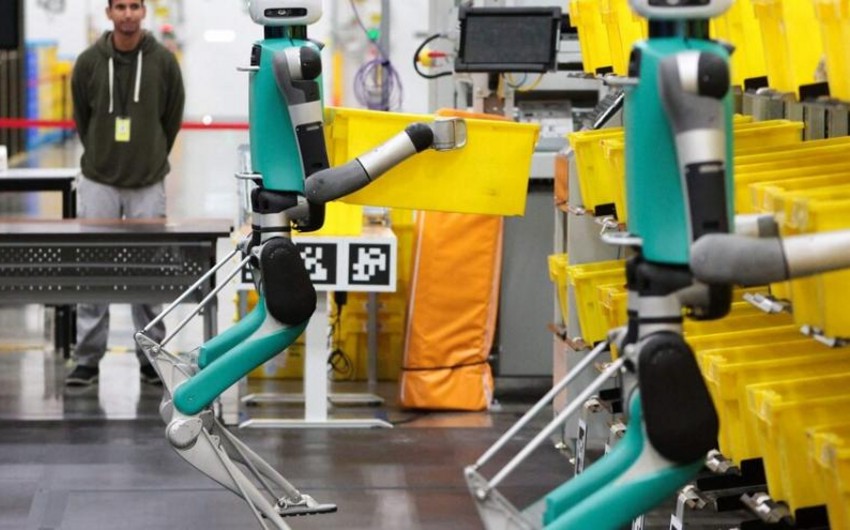The automation of Amazon.com facilities is approaching a new milestone: There will soon be as many robots as humans, The Wall Street Journal said, EDnews reports.
The e-commerce giant, which has spent years automating tasks previously done by humans in its facilities, has deployed more than one million robots in those workplaces, Amazon said. That is the most it has ever had and near the count of human workers at the facilities.
Company warehouses buzz with metallic arms plucking items from shelves and wheeled droids that motor around the floors ferrying the goods for packaging. In other corners, automated systems help sort the items, which other robots assist in packaging for shipment.
One of Amazon’s newer robots, called Vulcan, has a sense of touch that enables it to pick items from numerous shelves. Amazon has taken recent steps to connect its robots to its order-fulfillment processes, so the machines can work in tandem with each other and with humans.
“They’re one step closer to that realization of the full integration of robotics,” said Rueben Scriven, research manager at Interact Analysis, a robotics consulting firm.
Now some 75% of Amazon’s global deliveries are assisted in some way by robotics, the company said. The growing automation has helped Amazon improve productivity, while easing pressure on the company to solve problems such as heavy staff turnover at its fulfillment centers.
For some Amazon workers, the increasing automation has meant replacing menial, repetitive work lifting, pulling and sorting with more skilled assignments managing the machines.
“I thought I was going to be doing heavy lifting, I thought I was going to be walking like crazy,” said Neisha Cruz, who spent five years picking items at an Amazon warehouse in Windsor, Conn., before she was trained to oversee robotic systems.
Robots are also supplanting some employees, helping the company to slow hiring. Amazon employs about 1.56 million people overall, with the majority working in warehouses.
The average number of employees Amazon had per facility last year, roughly 670, was the lowest recorded in the past 16 years, according to a Wall Street Journal analysis, which compared the company’s reported workforce with estimates of its facility count.
The number of packages that Amazon ships itself per employee each year has also steadily increased since at least 2015 to about 3,870 from about 175, the analysis found, an indication of the company’s productivity gains.
Some of Amazon’s newer facilities, such as those built for same-day delivery, have “smaller employee footprints and help us deliver with greater speed,” a company spokesman said.
Amazon is also rolling out artificial intelligence in its warehouses, Chief Executive Andy Jassy said recently, “to improve inventory placement, demand forecasting, and the efficiency of our robots.” Amazon said it will cut the size of its total workforce in the next several years.
The second-largest private employer in the U.S., Amazon is a bellwether for a range of businesses automating work around the country. Its broad rollout of robots shows how technological advances are accelerating, transforming factory floors and rippling through labor markets.
The company began introducing advanced robotics to its warehouses after it paid $775 million in 2012 to buy Kiva Systems, which made robots that ferried shelves of products around.
Early on, robots moved large amounts of unpackaged items, a physically difficult task for a human to do. Over time, the machines began taking on even more challenging assignments, such as packaging, sorting products and lifting heavy items.
Amazon’s automation advances are on display at its 3-million-square-foot facility in Shreveport, La.
There, more than six dozen robotic arms sort, stack and consolidate millions of items. Robots also zip carts of packages for loading onto trucks, help package customer paper bags for orders and transport products to be in position for packaging.
One of the machines uses computer vision and small robotic arms.
Robots perform several tasks working with humans. The robotic system that helps sort inventory moves products to an employee, who then picks the items that fill an order. Another reaches for hard-to-grab items inside shelves, with the supervision of a human worker.
Products move 25% faster through the facility than at other sites.
Amazon has trained more than 700,000 workers across the world for higher-paying jobs that can include working with robotics, the company said.
Amazon has been testing a humanoid robot, its manufacturer Agility Robotics said. The robots, which have legs, arms and a head and have been tested with tasks such as recycling containers at Amazon, are still in research and development, Amazon said.
Amazon Robotics Chief Technologist Tye Brady said in an interview that the company will continue to need many workers and that new robots are meant to make their jobs easier, not displace them.
Sheheryar Kaoosji, executive director at the Warehouse Worker Resource Center, a nonprofit that advocates on behalf of warehouse employees, said robotics haven’t changed jobs as much in smaller Amazon sites as in large fulfillment centers to date.
Yet Kaoosji expressed concern about the longer-term impact on employment. The company’s “dream is to have a significant reduction of workforce in high-density facilities,” he said.










